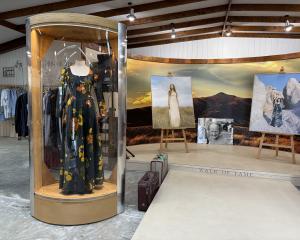Once again the Hokonui Fashion Design Awards proved its place as a top national fashion awards event by not only attracting record entries from around the country, but for the overall calibre of design. Jude Hathaway reports.
Before packed audiences at the the Gore Town and Country Club stadium, the 24th Hokonui Fashion Design Awards showed what it was made of and why it is the longest-running design competition of its type in New Zealand.
Imagination, originality and that little bit of passion was obvious in every section, nowhere more so than in the school category. This year saw 48 outfits from 18 schools, including one primary school.
Also adding a special sartorial take on things and bringing their own entertaining dynamic at last weekend's show, were the spectacular steampunk entries in both the school and open sections. Hooped and helmeted, corseted and laced, frilled or ruched - and many accessorised with Victorian driving goggles and rayguns - the outfits loosely referenced Victorian science fiction and the industrial 19th-century steam era.
Standout entries also peppered the other open sections, the number and level of entries creating a difficult task for the judging panel.
Back for her third time and heading the panel was Auckland's Doris De Pont, a designer for 24 years, who has also pursued postgraduate studies and has founded the New Zealand Fashion Museum. Also returning to the panel was James Dobson, of Auckland, who is behind the Jimmy D label. From Christchurch came long-time designer, fashion retailer and international fashion wholesaler Barbara Lee, who made her debut this year. It was also young Auckland designer Lela Jacob's first stint on the panel.
"The standard gets stronger every year and this was particularly so in this year's Collections section," said De Pont, who also remarked on the show's overall flawless execution.
There were the inevitable standouts, she said, no more so than the overall winning garment from the avant-garde section. Its dramatic aesthetic was matched by its name, Black Tide. The design by Charlotte Bishop, from the Otago Polytechnic School of Fashion's Tauranga campus, was made from poured latex and inspired by the oil spill from the Rena wreck.
"On the catwalk it may have been simply perceived as a black evening gown, but the workmanship and sculpturing of the garment was superb," De Pont said.
The opening Howl at the Moon Streetwear section showed everything from the dainty and decorous to the dashing and the dazzling, with breezy sorbet colours bringing a touch of summer to the catwalk in prints, colour blocks and plains. Pretty dresses, shorts and jackets, skirts and tops and bra tops were all there, in fabrics ranging from the traditional through to clear plastics.
The sheer diversity of treatments was the feature of the Carvin Streetwear Denim Award, which also brought serious originality to the catwalk. Here was denim as few have ever seen it. It came in flounced and layered, beaded and bustled, sliced and slivered and also pintucked and structured.
That same originality was on display in the Fredericks Menswear Section which, like the denim section, although comparatively small, did not lack in visual impact whether in the casual gear, the wool outfits or the innovative dressy co-ordinates.
But wool fittingly retained its starring hold on versatility as a fibre and fabric in a show that is staged in a major New Zealand wool-growing area.
Every dress code for women was represented, swinging from playsuits to evening dresses and everything in between. Sports and performance outfits showed alongside cocktail dresses, tights, tunics and togs.
Co-ordinated separates were worn under warm generous jackets, capes and crocheted tunics. It was also good to see contemporary styles in traditional hand knits.
Another crowd-pleaser was the Carvin Streetwear Collections Award, which requires collections to have three outfits resonating through colour, fabric and design.
This year saw collections of men's and women's wear, with one comprising a mix of both. Pop art and plastic, geometrics and origami provided showy punctuations.
Innovative textural finishes and fabric manipulation as well as clever colour combinations were all there. Move over Project Runway!Also bringing out a fabulous range of design styles, including that of the overall winner, was the VnC Cocktails Avant-garde Award. This year bridal wear vied for attention with ballet, botanical and elfin-inspired aspects. Glimpses of the carnival and Victoriana also captured attention.
A similar swathe of aesthetics was there in the Heartland Hotel Croydon Nightlife Award, with glamour, glitz and elegance galore for the ball or cocktail soiree.
As fresh and as sharply presented as ever and complete with a dash of that open-spirited Southland character, this year's event had an assured maturity that will carry it smoothly through to the landmark 25th show next year.












